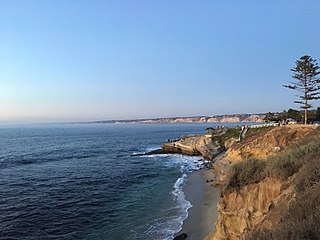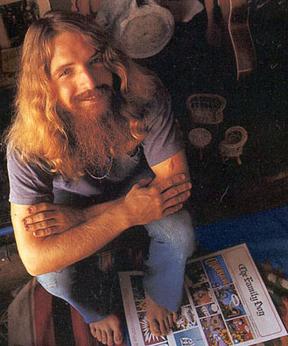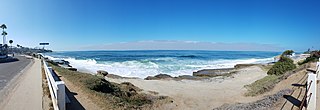Related Research Articles

Pacific Beach is a neighborhood in San Diego, bounded by La Jolla to the north, Mission Beach and Mission Bay to the south, Interstate 5 to the east and the Pacific Ocean to the west. While formerly largely populated by young people, surfers, and college students, because of rising property and rental costs the population is gradually becoming older and more affluent. "P.B.," as it is known as by local residents, is home to one of San Diego's more developed nightlife scenes, with a great variety of bars, eateries, and clothing stores located along Garnet Avenue and Mission Boulevard.

La Jolla is a hilly, seaside special community within San Diego, occupying 7 miles (11 km) of curving coastline along the Pacific Ocean. The population reported in the 2010 census was 46,781.

Richard Alden "Rick" Griffin was an American artist and one of the leading designers of psychedelic posters in the 1960s. As a contributor to the underground comix movement, his work appeared regularly in Zap Comix. Griffin was closely identified with the Grateful Dead, designing some of their best-known posters and album covers such as Aoxomoxoa. His work within the surfing subculture included both film posters and his comic strip, Murphy.

Ocean Beach is a beachfront neighborhood of San Diego, California.

Black's Beach is a secluded section of beach beneath the bluffs of Torrey Pines on the Pacific Ocean in La Jolla, San Diego, California, United States. It is officially part of Torrey Pines State Beach. The northern portion of Black's Beach is owned and managed by the California Department of Parks and Recreation, while the southern portion of the beach, officially known as Torrey Pines City Beach, is jointly owned by the city of San Diego and the state park, but is managed by the city of San Diego. This distinction is important as Black's Beach is most known as a nude beach, a practice that is now prohibited in the southern portion managed by the city of San Diego.

Torrey Pines State Beach is a public beach located in the San Diego, California community of Torrey Pines, south of Del Mar and north of La Jolla. Coastal erosion from the adjacent Torrey Pines State Reserve makes for a picturesque landscape. It is a local favorite among surfers and remains a quintessential Southern California beach. Occurrences of bioluminescence in the waters near the beach have been noted.

Skip Frye is an American surfer, surfboard designer and shaper, and environmental activist.

Charles M. Van Artsdalen was a surfer. He moved to La Jolla, California, from his birthplace of Norfolk, Virginia, at age 14. Van Artsdalen is best known as a pioneer of surfing 25-foot waves at such North Shore locations as Waimea Bay and Sunset Beach; and tube riding in Hawaii during the early 1960-1970s. A member of the Duke Kahanamoku Surf Team, he appeared in several surf movies and remained a fixture of the international surfing community until his death from alcohol-related illness in 1979.

Windansea Beach is a stretch of coastline located in the La Jolla community of San Diego, California. The neighborhood adjacent to the beach is named Windansea after the beach. It is named after the 1909 oceanfront Strand Hotel that was renamed "Windansea" Hotel in 1919 after the owner Arthur Snell ran a "naming contest". The Windansea Hotel which was located on Neptune Avenue between Playa del Sur and Playa del Norte burned down in 1943. Geographically, it is defined by the beachfront extending north of Palomar Avenue and south of Westbourne Street.

Michael Dormer or Michael Henry Dashwood Dormer was an American fine artist, writer, songwriter, entrepreneur, and creator of the 1960s TV show Shrimpenstein.
John Duncan "Jack" Macpherson III was a former mailman and bartender in San Diego, California. According to his Los Angeles Times obituary, he was a local legend who acquired "a permanent niche in the history of Southern California beach culture".
Bill Andrews (1944-2017) was a surfer, documentary photographer/videographer, and archivist. During his daily reportage of modern surf culture, Andrews archived over 20,000 surf-related photographs and videos. His work can be seen on the online chronicle "A Day with BA" and on youtube.
Corky Carroll is a professional American surfer and is considered a pioneer in the sport by becoming the first real professional surfer as well as being the first to make paid endorsements.
Surf Diva is recognized internationally as Southern California’s original all-women's surf school.

Marine Street Beach is a public beach located in the community of La Jolla in San Diego, California, on the Pacific Ocean. It sits at the western terminus of Marine Street, with Children's Pool Beach to the north and Windansea Beach to the south. The surf has been described as rough and not suitable for children. However, the rough surf has made the beach popular with surfers and bodyboarders. Nearby kelp beds host marine life making the area a popular dive spot.
South La Jolla State Marine Conservation Area (SMCA) and South La Jolla State Marine Reserve (SMR) are two adjoining marine protected areas that extend offshore in San Diego County on California’s south coast. The two marine protected areas cover 7.51 square miles. The SMR protects marine life by prohibiting the removal of marine wildlife from within its borders, while the SMCA limits removal of marine wildlife.
Bird Rock is a seaside neighborhood within the larger community of La Jolla in San Diego, California. It lies on the Pacific Ocean at the southernmost end of La Jolla, just north of Pacific Beach. The mostly residential neighborhood includes homes for 1,400 to 1,500 families, with a commercial district along the main street, La Jolla Boulevard. The shore is rocky and has no beach, but offshore reefs are used for surfing.

Tourmaline Surfing Park is a beach access point and a surf spot in North Pacific Beach, San Diego, California, USA. The park is situated at the northern end of Pacific Beach, a short distance south of where the sand beach ends and the rocky promontory of La Jolla begins. There are cliffs to the north and south of Tourmaline Surfing Park, but the park itself lies in Tourmaline Canyon, which cuts down through those cliffs to the beach.
"Surfin' U.S.A." is a song by the American rock band the Beach Boys, credited to Chuck Berry and Brian Wilson. It is a rewritten version of Berry's "Sweet Little Sixteen" set to new lyrics written by Wilson and an uncredited Mike Love. The song was released as a single on March 4, 1963, backed with "Shut Down". It was then placed as the opening track on their album of the same name.
References
- ↑ https://photostore.sandiegohistory.org/wp-content/uploads/product/Surfing-icon-Hot-Curls-1963-UT85_D2703-5.jpg [ bare URL image file ]
- ↑ Powers, Michael; Reynolds, Eric (2017). Michael Dormer and the Legend of Hot Curl. Fantagraphics Books. ISBN 9781683960171.
- ↑ "Hot Curl – la Jolla, WindanSea Shack Icon".
- ↑ "San Diego Community News Group - OB artist Michael Dormer 77 OB artist and Renaissance man". www.sdnews.com. Archived from the original on 2017-09-24.
- ↑ "San Diego Historical Society". www.sandiegohistory.org. Archived from the original on 2 September 2001. Retrieved 13 January 2022.
- ↑ "Windansea Beach, La Jolla | San Diego Reader".
- ↑ Fantasy Fantasy Femmes of Sixties Cinema: Interviews with 20 Actresses from Biker, Beach, and Elvis Movies. Tom Lisanti. ISBN 978-0-7864-0868-9. 2001
- ↑ "Rick Griffin Biography".
- ↑ "The Legend of Hot Curl".
- ↑ "RIP Mike Dormer (1935-2012)". 28 September 2012.